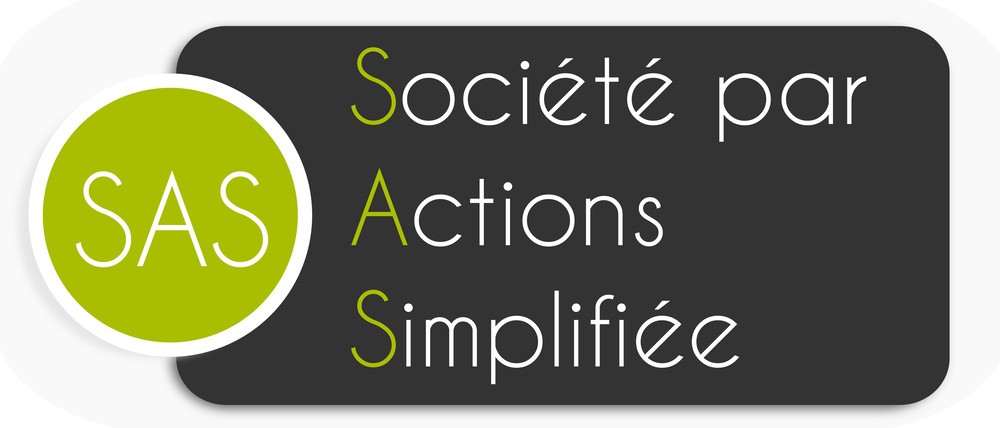La SAS, simplified joint stock company, is a form of business that is increasingly widespread today. It is with the SARL, one of the two most popular options for project leaders who wish to work in a company. Here are the main legal particularities of the SAS.

Article summary
ToggleWhat SAS can do
Most legal activities are practicable in SAS, regardless of the field of activity. The SAS is a commercial structure.
However, certain professions are reserved for other legal forms, for example tobacco shops.
Amount of capital for the SAS
La Société par Actions Simplifiées must determine a capital, the amount of which is defined in the articles of association. No minimum sum required.
An SAS can also have variable capital.
Cash contribution in SAS
Shareholders have the option of providing cash contributions in SAS, contributions in kind and contributions in industry.
Contributions in industry do not contribute to the establishment of social capital.
In the case of'in-kind contributions, the engagement of a contribution auditor is generally required. However, shareholders have the option of saving money in certain cases.
SAS partners
At least a member is necessary to create an SAS, and there is no cap. In the case of a single person, it is then a SASU.
In compensation for the contributions to the SAS, the partners receive shares. These titles give them access to several privileges:
- Financial privileges (dividends, liquidation bonus, etc.),
- Political privileges, including the right to vote at assemblies,
- Information privileges, both continuous and prior to each meeting,
- Other type of privileges, such as the right to take legal action against the leaders.
The SAS partners must fulfill several commitments:
- They are responsible for the social liabilities, within the limit of their contributions,
- And undertake to release the money and/or the goods that they provided to the SAS during the creation.
Implementation of SAS management
La The management of the SAS is ensured by the president of the company.
It is possible to set up various governance structures: managing directors, deputy managing directors, management committee, board of directors, etc. The operating methods of these different bodies are determined in the articles of association.
Even if the articles of association provide that other managers benefit from the same powers as the president, it is the latter who represents the company towards third parties.
Compared to the partners, the chairman is endowed with the broadest powers to act on behalf of the company within the limits of the corporate purpose. Statutory restrictions cannot be invoked against third parties.
Le designation of the first president is imposed in the articles of incorporation.
Collective decision-making of SAS partners
Depending on their nature, the jurisdictions of SAS associations are governed by decisions taken at Ordinary or Extraordinary General Meetings.
The SAS statutes must determine what measures must be taken at the GM, and it is mandatory to use them to:
- Share capital change operations (SAS capital increase, reduction or amortization),
- Merger, demerger or dissolution operations,
- Designation of a Statutory Auditor,
- Approval of the annual accounts and allocation of profits,
- Conversion to another legal form.
The SAS statutes also govern the operation of meetings: rules for calling, deadlines, meetings and majority rules.
However, the unanimity of the partners is required for the following decisions:
- Any operation that increases the commitment of the associates,
- Adoption of rules concerning the inalienability of shares, the approval of shareholders or the exclusion of a partner.
Legal particularities of the SAS
Here are the main legal particularities for the SAS :
- The SAS must have a corporate name and a seat ;
- La Sustainability of the SAS is determined in the statutes, it cannot exceed 99 years;
- The closing date of the accounting year is defined in the articles of association, each financial year has a duration of 12 months, except for exceptions (in particular for the first financial year),
- Transfers of shares are generally free, but the articles of association or a pact between members may limit them.
The partners have the possibility of inserting various provisions in the articles of association, provided that they are not contrary to the legislation.
Drafting of the statutes of the SAS
When setting up a Simplified Joint Stock Company (SAS), it is necessary to draft articles of association which must contain the following information:
- The legal form of the company,
- The duration of the SAS,
- The name of the SAS,
- THEsocial object of SAS,
- SAS head office,
- The amount of the share capital of the SAS,
- The form of SAS shares,
- The number and specific rights attached to the categories of shares,
- The subscription conditions for shares linked to contributions in industry,
- Special benefits granted to partners,
- The managers of the SAS,
- The operating procedures of the management bodies of the SAS,
- The forms and conditions to be observed in order to make decisions as a partner,
- The first auditors,
- The distribution of the result, reserves and liquidation surplus,
- The persons who signed or had the articles of association signed.
SAS partners can add additional clauses in the articles of association, to organize the operation of SAS. Let us mention among others:
- A disclaimer,
- A agreement clause transfer of shares,
- A inalienability clause,
- A right of first refusal,
- A joint exit clause…
The articles of association are drawn up in writing, by private deed or by notarial deed. For any modification of the articles of association, an extraordinary decision of the partners is required (except in exceptional cases).
Formation of a simplified joint-stock company
To finalize the procedure creation of an SAS, the file including the necessary documents must be submitted to the competent CFE (Centre de Formalités des Entreprises). The documents to be provided are as follows:
- A copy of SAS statutes signed by all the partners,
- An M0 form signed by the president or by an authorized person,
- A proxy for the president if he does not sign the M0 form,
- The certificate of the depositary of the funds with the list of subscribers,
- The certificate of publication of thenotice of incorporation of the SAS in a journal of legal notices,
- The justification for the regular use of the premises of the head office,
- For regulated activities: a copy of the documents necessary for the exercise of the activity,
- A possible copy of the contribution auditor's report,
- The act of appointment of the auditor and his deputy,
- The deed of appointment of the president and other managers if they are not mentioned in the statutes,
- For the president and the other leaders: a declaration of non-conviction, a certificate of parentage and a copy of the identity document,
- If the president is a legal person: an RCS extract of less than 3 months,
- Court fees related to the registration of the company.
Appointment of an auditor in SAS
In terms of simplified joint stock companies (SAS), the appointment of an auditor is necessary as soon as the company exceeds one of three thresholds following:
- Annual sales : 8 000 000 €,
- Total assets : 4 000 000 €,
- Employee workforce: 50.
These criteria are verified for the SAS or the entire group if it is the leader. If the SAS is controlled by another company and these two entities jointly exceed two of the three thresholds, the SAS must appoint an auditor if it alone crosses the following two thresholds:
- Annual sales : 4 000 000 €,
- Total assets : 2 000 000 €,
- Employee workforce: 25.
In addition, the appointment of an auditor may be ordered:
- By the court, at the request of one or more partners representing at least 10% capital,
- Directly by the SAS at the reasoned request of one or more partners representing at least 1/3 of capital.

